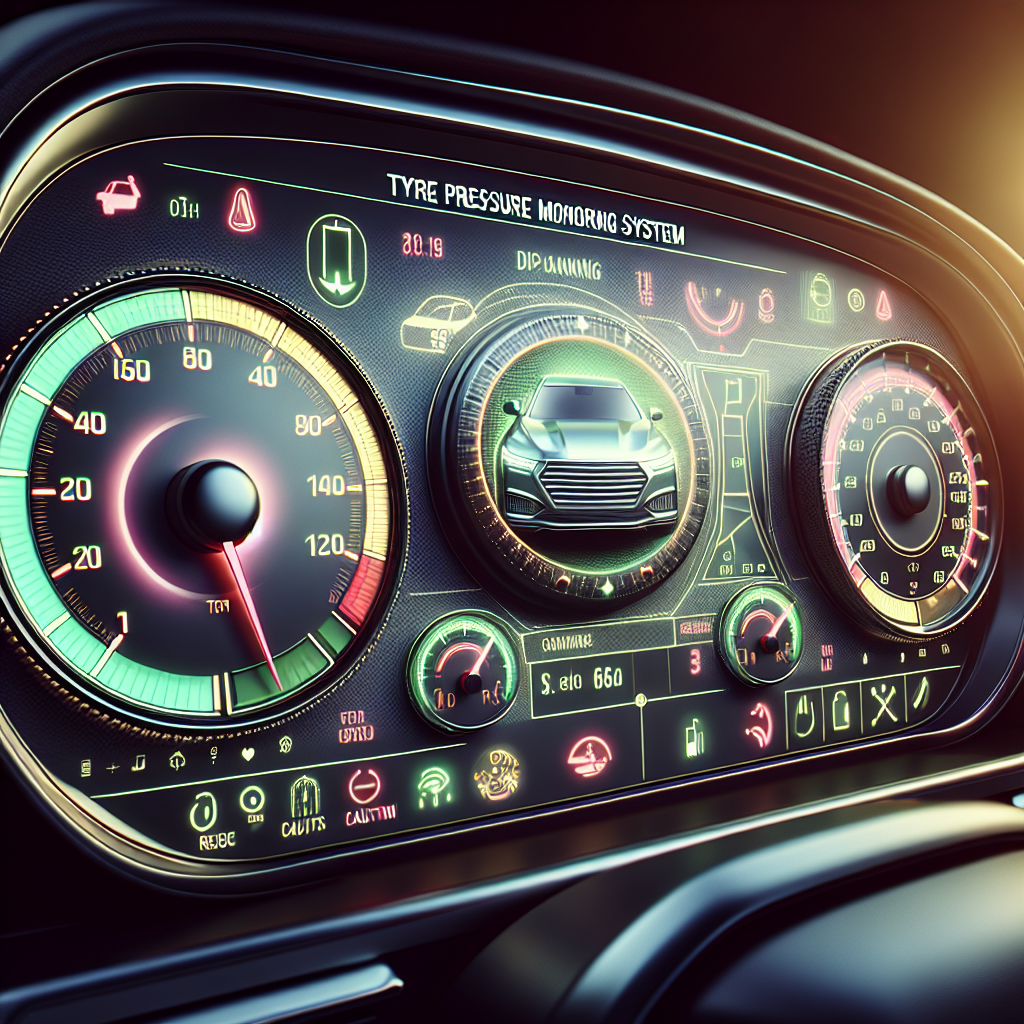When it comes to vehicle safety, maintaining proper tyre pressure is essential. A tyre pressure monitoring system (TPMS) plays a pivotal role in ensuring that your tyres are inflated to the optimal level, thereby enhancing both your safety and the performance of your vehicle. Understanding the importance of tyre pressure monitoring can help you prevent potential accidents and costly repairs.
Firstly, under-inflated tyres can lead to a multitude of issues, such as:
- Reduced Fuel Efficiency: When tyres are not properly inflated, they create more rolling resistance, forcing the engine to work harder and consume more fuel.
- Poor Handling: Low tyre pressure can compromise your vehicle's handling, making it difficult to steer and increasing the risk of a loss of control.
- Increased Wear and Tear: Improperly inflated tyres wear out faster, leading to more frequent replacements and higher long-term costs.
- Higher Risk of Blowouts: Insufficient pressure raises the likelihood of tyre blowouts, which can be dangerous and result in severe accidents.
Implementing a TPMS allows for real-time monitoring of tyre pressure, alerting drivers to any abnormalities before they escalate into serious issues. By maintaining optimal tyre pressure, drivers can enhance their safety and prolong the life of their tyres.
Tow with peace of mind, knowing that trailerwatchdog is standing guard.
How Tyre Pressure Monitors Operate Mechanically

Understanding how tyre pressure monitors operate mechanically is crucial for appreciating their role in vehicle safety. A typical tyre pressure monitoring system (TPMS) consists of several components that work together to provide real-time data on tyre pressure.
There are two main types of TPMS: direct and indirect. Each type functions differently:
- Direct TPMS: This system employs pressure sensors located within each tyre. These sensors measure the actual pressure of the tyre and transmit this information wirelessly to the vehicle's onboard computer. When the pressure drops below a predefined threshold, the driver is alerted through a dashboard warning light. Direct systems are known for their accuracy and provide real-time data.
- Indirect TPMS: Unlike direct systems, indirect TPMS does not use pressure sensors. Instead, it relies on the vehicle's anti-lock braking system (ABS) to monitor the rotational speed of each tyre. If a tyre is under-inflated, it will rotate faster than properly inflated tyres, triggering a warning signal. While indirect systems are often less expensive, they may not provide precise pressure readings.
In both systems, the core function remains the same: to ensure that tyre pressure is constantly monitored and to alert the driver of any discrepancies. This proactive approach not only enhances safety but also improves fuel efficiency and extends tyre life.
Key Components of Tyre Pressure Monitoring Systems

The efficiency and accuracy of tyre pressure monitoring systems (TPMS) hinge on several key components that work harmoniously to keep drivers informed about their vehicle’s tyre condition. Understanding these components is essential for recognizing the value of a TPMS.
Here are the primary components that make up a TPMS:
- Pressure Sensors: These are the heart of direct TPMS. Each tyre is equipped with a sensor that measures the air pressure inside. These sensors can either be integrated into the valve stem or mounted inside the tyre, ensuring accurate readings.
- Receiver Unit: This component is responsible for receiving data transmitted from the pressure sensors. It processes the information and communicates with the vehicle’s onboard computer, ensuring that the driver receives timely alerts.
- Dashboard Display: The dashboard display is where the driver receives feedback about tyre pressure levels. It can indicate normal pressure, alert the driver of low pressure, and sometimes even display specific tyre pressures for each wheel.
- Battery: Most pressure sensors are powered by batteries, which can vary in lifespan. Regular maintenance checks are essential to ensure that the sensors remain operational.
- Software Interface: The software within the TPMS processes the data collected from the sensors and determines whether the tyre pressure is within the acceptable range. It also helps in diagnosing issues or failures within the system.
By combining these components, a TPMS provides an efficient and reliable way to monitor tyre pressure, enhancing safety and performance on the road.
Benefits of Using Tyre Pressure Monitors for Safety

Utilizing tyre pressure monitors (TPMS) offers numerous advantages that significantly enhance vehicle safety and performance. These systems not only provide real-time data but also help in preventing potentially hazardous situations on the road. Below are some key benefits of using tyre pressure monitors:
- Enhanced Safety: By continuously monitoring tyre pressure, TPMS alerts drivers to any significant drops, which can prevent blowouts and loss of control while driving.
- Improved Fuel Efficiency: Maintaining optimal tyre pressure reduces rolling resistance. Under-inflated tyres can lead to increased fuel consumption, and a TPMS helps ensure that tyres are always at their best pressure.
- Extended Tyre Life: Properly inflated tyres wear evenly and last longer. By consistently monitoring pressure, a TPMS can help prevent uneven wear, ultimately extending the life of your tyres.
- Environmental Benefits: By improving fuel efficiency and reducing tyre waste, TPMS contributes to lower emissions, making it an eco-friendly choice for vehicle maintenance.
- Convenience: TPMS provides real-time alerts directly to the dashboard, allowing drivers to be proactive rather than reactive about their tyre health. This convenience means less time spent worrying about tyre conditions.
Incorporating a TPMS into your vehicle not only promotes a safer driving experience but also offers practical benefits that can lead to savings in the long run.
Common Issues with Tyre Pressure Monitoring Systems
While tyre pressure monitoring systems (TPMS) are invaluable for ensuring safety and performance, they are not without their challenges. Understanding these common issues can help users maintain their systems effectively and avoid potential problems:
- Sensor Malfunction: One of the most frequent issues is the failure of the sensors. These sensors can become damaged or corroded, often due to harsh weather conditions or road debris, leading to inaccurate readings.
- Battery Life: Many TPMS sensors operate on batteries that have a limited lifespan. When these batteries fail, the system may stop functioning, resulting in a lack of tyre pressure data.
- Calibration Issues: After installing new tyres or sensors, the TPMS may require recalibration. If this step is overlooked, the system may provide false alerts or fail to alert the driver altogether.
- Interference: Electronic interference from other devices can sometimes disrupt the communication between the TPMS and the vehicle's onboard computer, leading to erroneous readings or alerts.
- Temperature Sensitivity: TPMS sensors can be sensitive to temperature changes. Extreme cold or heat can affect tyre pressure, leading to false readings or alerts that may not accurately reflect the actual tyre condition.
Being aware of these common issues can empower drivers to take proactive measures, such as regular maintenance and timely sensor replacements, ensuring that their TPMS remains an effective tool for road safety.
Maintaining Your Tyre Pressure Monitoring System Effectively

To maximize the effectiveness of your tyre pressure monitoring system (TPMS), regular maintenance is essential. A well-maintained TPMS not only enhances safety but also extends the lifespan of your tyres. Here are some practical tips to keep your system in top shape:
- Regular Checks: Periodically inspect your sensors for any signs of damage or corrosion. If you notice any issues, replace the sensors immediately to ensure accurate readings.
- Battery Maintenance: Keep track of the battery life of your TPMS sensors. Most sensors will alert you when the battery is low, but regular checks can prevent unexpected failures.
- Calibration: After any tyre changes or repairs, always recalibrate your TPMS. This can usually be done through your vehicle's onboard computer, but refer to the manufacturer’s instructions for specifics.
- Temperature Monitoring: Be mindful of extreme temperature changes, which can affect tyre pressure. Regularly check tyre pressures when the temperature fluctuates significantly.
- Professional Inspections: Consider having your TPMS checked during routine vehicle maintenance. Professionals can ensure that all components are functioning correctly and make necessary adjustments.
By following these maintenance tips, you will not only enhance the safety of your driving experience but also ensure that your tyre pressure monitoring system operates optimally. Tow with peace of mind, knowing that trailerwatchdog is standing guard.








